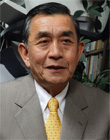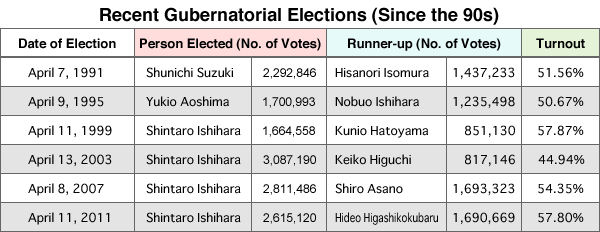Top>Opinion>Reflections on the Tokyo Gubernatorial and Nationwide Local Elections
 Index
Index

Nobuo Sasaki [Profile]
Reflections on the Tokyo Gubernatorial and Nationwide Local Elections
Nobuo Sasaki
Professor, Faculty of Economics, Chuo University
Area of Specialization: Public Administration and Local Autonomy
Democratic Party Politics: Missing the Mark
Japan's first nationwide local elections under the Democratic Party Administration are being held to elect mayors and assemblies in the cities, towns, wards, and villages of many prefectures. Rather than just another round of local elections held once every four years, this occasion has brought attention to how the Democratic Party's emphasis on soft policies towards citizens are being regarded at the local level.
Unfortunately, even if we exclude the anomaly of the unprecedented great earthquake from consideration, they appear to come up short. The Democratic Party saw a reduction in their seats in 41 prefectural parliaments, and apart from the 12 safe gubernatorial elections all of the party's favored candidates suffered crushing defeats. Although it is still impossible to draw general conclusions until April 24 because the remainder of these municipal elections will be held on that day, the trend is clearly not going to change.
Lowest Turnout in History
In a campaign stifled by the great earthquake, special focus was given only to earthquake disaster reconstruction, prevention measures, and the nuclear power plant problems, while treatment of local sovereignty, the declining birthrate and growing proportion of elderly people, living standards, unemployment, and local revitalization-which were to be questioned originally-were sidestepped.
Influenced by this, voter turnout for the prefectural parliament elections was a mere 48%, the lowest since the war, and some areas like Saitama sank below 40%. The 12 gubernatorial elections saw only three new governors elected, as social conditions favored the incumbents, nine of whom were re-appointed, with Shintaro Ishihara securing a fourth term.
This round of local elections had three discernible characteristics. First of all, while the solidarity of residents and autonomous roles came under review, there was no switch to election mode and hardly any debate. The second aspect is the inevitability of many of the gubernatorial elections, wherein the safe nature of contests such as those between incumbents and candidates from the communist party made the outcome predictable from the start. The third aspect of these elections is the fact that 34 of the 41 prefectural parliament elections recorded their lowest voter turnout ever, with a considerable number of constituencies experiencing wins by default. Despite this fundamental disillusionment with prefectural assemblies, it is very likely that this will provide the chance for discussion on compensation for local elected representatives, problems about the number of assembly seats and whether these assemblies are really necessary in the first place.
Tokyo Gubernatorial Election - Why Ishihara was Elected Governor for a Fourth Term
Meanwhile, the Tokyo gubernatorial election attracted a fair amount of attention. In contrast to the sharp decline predicted at the start, voter turnout reached 57.8%, and was close to topping the turnout figures for the last 20 years (see table). This is probably a reflection of the fact that voters, filled with a sense of crisis after the great earthquake, were earnestly seeking a leader to guide them, and Shintaro Ishihara, criticized for his age and frequent appearances in these elections collected 2,610,000 votes in a resounding victory.

More likely, this is a result borne out of a big change in voting psychology following the great earthquake of March 11. Just when former Miyazaki Governor Higashikokubaru and others had made the lineup of candidates, Mr. Ishihara, having asserted that he would not run for a fourth term, went back on his word and suddenly decided to throw his hat in the ring for re-election. Twenty minutes after his declaration, on the final day of the Metropolitan Assembly, the phantom earthquake struck.
Criticism hovered over Mr. Ishihara for his trickery and the Machiavellian way he entered the contest while Kanagawa Governor Matsuzawa was being thought of as his successor, but voters grew increasingly inclined towards choosing a strong leader in the wake of the unprecedented devastation suffered as a result of the great earthquake, enormous tsunami, and nuclear power plant disaster. This led to a gamble on the incumbent Mr. Ishihara, who declared, "I will operate in the same way," lacking fresh ideas.
If asked to evaluate this Tokyo gubernatorial election, I would say that it lacked discussion on the issues due to the consensual nature of the current earthquake disaster measures and have to label the campaign as one fought in terms of image and personality. The ruling Democratic Party is the biggest factor accounting for this political situation. In the gubernatorial election, the Democratic Party lost by default to choose the governor who can be regarded as an additional Prime Minister.
What's more, the turmoil of the state not knowing how to respond to the great earthquake gave way to kneejerk reactions, and heightened attention on the image of the straightforward, autocratic leader, Shintaro Ishihara.
Currently, around 60% of Japan's 47 governors share a mid-level bureaucratic background, with many of them only in their forties or fifties. In this respect, Mr. Ishihara, who will soon be 80, is clearly somewhat of a rarity, regardless of his track record. Japan seems compelled to appoint this veteran politician considered a "governor among governors" and "commanding figure stronger than the prime minister" to the post of Governor of Tokyo, but how is such a sterile political scene and leadership situation perceived by international society?
The Next Metropolitan Administration: Towards a Changed Perspective
Having been elected for a fourth term as Governor of Tokyo, Mr. Ishihara needs to vigorously apply himself to the task of running the metropolitan administration. Were the economy of Tokyo-which occupies 20 percent of the gross domestic product (GDP) and 40 percent of national tax revenue-to go into decline, this would have direct repercussions on the national crisis. This is why Mr. Ishihara, who vowed that "Tokyo will save Japan", must enter the cabinet as Deputy Prime Minister and fulfill his commitments.
The first item on the agenda is to use Tokyo's power to provide the best possible support for the reconstruction of the four prefectures ravaged by the disaster. Tokyo's efforts to overcome the crisis are inextricably linked to the earliest possible revival of the disaster-stricken areas.
If possible, Tokyo should forget its bid for the Olympic Games and be willing to pump funds of 400 billion yen to support the restoration.
The second item is Tokyo's own countermeasures against earthquake disasters. There is a need to overhaul the existing disaster plan, which assumes a magnitude seven earthquake to accommodate a magnitude ten scenario. It is vital that we reexamine policies on: all personal and impersonal aspects of earthquake disasters from building standards; the redevelopment of road networks; the withdrawal of footbridges; the measures for stranded commuters; the strengthening of electric power and communications facilities; the stockpiling of water and food; the systems providing medical treatment and emergency services; and the drills, evacuation routes, and local disaster prevention measures.
Thirdly, in addition to this, there is no time to waste in taking action to handle the change in Tokyo's social structure, specifically the trend toward an aging population. The demand for measures to address the aging population problem, such as medical treatment, welfare, and nursing, will increase dramatically. Mr. Ishihara's 12-year metropolitan administration has been a little lax in this regard. We cannot afford to keep doing the same things. There is a need to strengthen ties between Tokyo and the three adjoining prefectures from the standpoint of big city management.
We should strive to transform our paradigm on policies tackling the aging population, economy, employment, and international strategies.
This time, many young men supported Mr. Higashikokubaru. Every effort should be made to incorporate these policies and make Tokyo a place that inspires. Tokyo's rebirth lies in Mr. Ishihara, the final service.
- Nobuo Sasaki
Professor, Faculty of Economics, Chuo University
Area of Specialization: Public Administration and Local Autonomy - Born in Iwate Prefecture in 1948, Nobuo Sasaki completed his masters at the Graduate School of Political Science, Waseda University before receiving his doctorate in law from Keio University. After working for the Tokyo Metropolitan Government, he became a professor at Seigakuin University in 1989 and then a professor at Chuo University in 1994. Chairman of the Japan Society for Local Democracy, he was also appointed Cooperative Member for the Science Council of Japan (Political Studies), and provided news commentary for NHK TV's Shiten Ronten and TOKYO MX TV. His recent literary works include The Governor of Tokyo [Tochiji], The Regional System [Doushusei], Local Assembly Representatives [Chihou Giin], Modern Local Assembly Representatives [Gendai Chihou Jichi] and How to Change Local Government [Chihou Jichitai Wo Dou Kaeru Ka]. He also frequently contributes to newspapers and magazines, and has established a reputation for providing lectures that are readily understood.
- Research Activities as a Member of Research Fellowship for Young Scientists (DC1), Japan Society for the Promotion of Science (JSPS) Shuma Tsurumi
- Important Factors for Innovation in Payment Services Nobuhiko Sugiura
- Beyond the Concepts of Fellow Citizens and Foreigners— To Achieve SDGs Goal 10 “Reduce Inequality Within and Among Countries” Rika Lee
- Diary of Struggles in Cambodia Fumie Fukuoka
- How Can We Measure Learning Ability?
—Analysis of a Competency Self-Assessment Questionnaire— Yu Saito / Yoko Neha - The Making of the Movie Kirakira Megane








